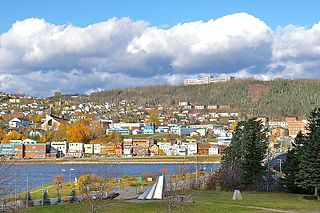Related Research Articles

Jean-Baptiste Biot was a French physicist, astronomer, and mathematician who co-discovered the Biot–Savart law of magnetostatics with Félix Savart, established the reality of meteorites, made an early balloon flight, and studied the polarization of light.

Evangeline Parish is a parish located in the U.S. state of Louisiana. As of the 2020 census, the population was 32,350. The parish seat is Ville Platte.

Ville Platte is the largest city in, and the parish seat of, Evangeline Parish, Louisiana, United States. The population was 7,430 at the 2010 census, down from 8,145 in 2000. The city's name is of French origin, roughly translating to "flat town", in reference to its relatively flat topography in contrast to the more hilly terrain north of the area.
New Sarpy is a census-designated place (CDP) in St. Charles Parish, Louisiana, United States. The population was 1,169 at the 2020 census.

L'Anse is a village and the county seat of Baraga County, Michigan. The population was 1,874 at the 2020 census. The village is located within L'Anse Township in the Upper Peninsula, and partially inside the L'Anse Indian Reservation.

St. Charles Parish is a parish located in the U.S. state of Louisiana. At the 2020 census, its population was 52,549. The parish seat is Hahnville and the most populous community is Luling.

L'Anse-Saint-Jean, French for "The Cove of Saint John" is a municipality in the Saguenay–Lac-Saint-Jean region of Quebec, Canada. Its population was 1208 in the Canada 2011 Census.

Gaspé is a city at the tip of the Gaspé Peninsula in the Gaspésie–Îles-de-la-Madeleine region of eastern Quebec in Canada. Gaspé is located about 650 km (400 mi) northeast of Quebec City, and 350 km (220 mi) east of Rimouski. As of the 2021 Canadian Census, the city had a total population of 15,063.

L'Anse Amour is a small village on the Strait of Belle Isle in Labrador, a part of the Canadian province of Newfoundland and Labrador. As of 2006, it had a population of 8 (1996), down from a total of 14 returned five years earlier. The settlement has not been returned separately since, though the 'between communities' population of Subdivision 10A has grown in the intervening years to a total of 20 by 2016, of which L'Anse Amour may reasonably be assumed to contain much of it. L'Anse Amour is located along Route 510.

Jean-Baptiste Le Moyne de Bienville, also known as Sieur de Bienville, was a French colonial administrator in New France. Born in Montreal, he was an early governor of French Louisiana, appointed four separate times during 1701–1743. He was the younger brother of explorer Pierre Le Moyne d'Iberville.

Jean-Noël Destréhan de Tours was a Creole politician in Louisiana and one-time owner of St. Charles Parish's Destrehan Plantation, one of Louisiana's historic antebellum landmarks. The community of Destrehan was named for his family.

Austin Pitre was born in Ville Platte, Louisiana. A Cajun music pioneer, Pitre claimed to be the first musician to play the accordion standing up, rather than sitting down. Along with his band, the Evangeline Playboys, Pitre recorded Cajun dancehall hits such as the "Opelousas Waltz."

Nicolet is the county seat of Nicolet-Yamaska Regional County Municipality, Quebec, Canada. The population as of the Canada 2016 Census was 8,169. It is the seat of the Roman Catholic Diocese of Nicolet.

Milton is an unincorporated community and census-designated place in Lafayette Parish, Louisiana, United States. At the 2010 U.S. census it had a population of 3,030; at the 2019 American Community Survey, it had an estimated population of 2,299. Milton is part of the Lafayette metropolitan statistical area.
Roberts Cove is an unincorporated community in Louisiana, United States.

The Courir de Mardi Gras is a traditional Mardi Gras event held in many Cajun and Creole communities of French Louisiana on the Tuesday before Ash Wednesday. Courir de Mardi Gras is Louisiana French for "Fat Tuesday Run". This rural Mardi Gras celebration is based on early begging rituals, similar to those still celebrated by mummers, wassailers, and celebrants of Halloween. As Mardi Gras is the celebration of the final day before Lent, celebrants drink and eat heavily, dressing in specialized costumes, ostensibly to protect their identities. In Acadiana, popular practices include wearing masks and costumes, overturning social conventions, dancing, drinking alcohol, begging, trail riding, feasting, and whipping. Mardi Gras is one of the few occasions when people are allowed to publicly wear masks in Louisiana. Dance for a Chicken: The Cajun Mardi Gras, a documentary by filmmaker Pat Mire, provides great insight into the history and evolution of this cultural tradition. In popular culture, two HBO series also make reference to the tradition.
Mouton is an unincorporated community in Lafayette Parish, Louisiana, United States.

L'Anse aux Meadows is an archaeological site, first excavated in the 1960s, of a Norse settlement dating to approximately 1,000 years ago. The site is located on the northernmost tip of the island of Newfoundland in the Canadian province of Newfoundland and Labrador near St. Anthony.

L'Anse-à-l'Orme Nature Park is a large nature park in the Pierrefonds-Roxboro borough of Montreal, Quebec, Canada.
References
- ↑ "www.lansegrise.org "Some Early Pioneers of L'Anse Grise"". Archived from the original on June 2, 2007. Retrieved December 18, 2007.
- ↑ "www.lansegrise.org "L'Anse Grise Community Website"". Archived from the original on October 21, 2007. Retrieved December 18, 2007.
